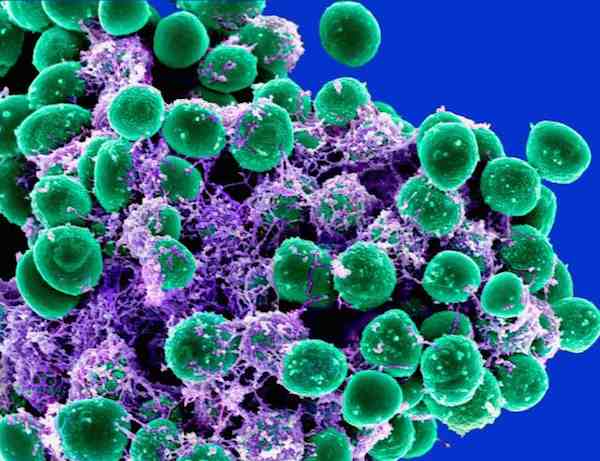
[Image above] Credit: NIAID; Flickr Creative Commons License.

Scientists have created visible light-upconverting yttrium silicate ceramics that have antibacterial surface properties. Credit: J. Kim; Yale University
Photon upconversion is like a materials’ magic trick—the material absorbs low-energy visible photons and converts them into high-energy ultraviolet photons, right before your very eyes. In this case, the magician’s hidden secret is anti-Stokes emission.
Now, scientists from Yale University, Georgia Institute of Technology, and Chonbuk National University (South Korea) have invited ceramics to the magic show.
Their paper, published in Environmental Science & Technology (login required), details the synthesis of antimicrobial ceramics that can kill bacterial bugs through simple exposure to ambient visible light.
The team, led by engineering professor Jaehong Kim, had previously reported using upconverting phosphor powders for antimicrobial coatings, but they wanted to find a better and more applicable material for their technology. The authors chose ceramics because, as they describe in the paper, the “structural characteristics of ceramics are also ideal for self-disinfecting surfaces. Ceramic materials are easy to clean, resistant to wear and harsh chemicals, and are already frequently used in a range of environments.”
The scientists made the ceramics through “high-temperature sintering of compacted yttrium silicate powders doped with Pr3+ and Li+,” according to the paper’s abstract.
They then tested these ceramics’ superpowers against bacterial spores, the dormant and hardy form of bacteria that are designed to survive in the environment. In their own words, they wanted to test spores “to ensure that visible light, heat, and natural bacteria mortality could be ruled out as causes of inactivation.”
The upconverting ceramics had almost four-times the bacterial spore-inactivating power of the team’s previous phosphor coatings. While exposure to a normal fluorescent light took several days to achieve this inactivation, the fact that spores were used is a huge factor. Normal vegetative bacteria (those that are growing and dividing) would be much more susceptible to inactivation.
“We are already working with new material compositions to produce ceramics with higher upconversion efficiencies and tailored emission ranges,” Kim says in an email. “With continued advances, we believe that visible-to-UVC upconversion ceramics could benefit a host of antimicrobial applications, including surface disinfection in hospitals and other environments with a high risk of disease transfer. This technology could also be used to disinfect drinking water simply through exposure to sunlight.”
The paper is “Synthesis and characterization of visible-to-UVC upconversion antimicrobial ceramics” (DOI: 10.1021/es405229p).
I feel a nerdy science joke coming on. A bacteria walked onto a ceramic and said, “What’s up, conversion?”…
Author
April Gocha
CTT Categories
- Basic Science
- Material Innovations


